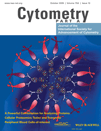In this issue
Visualizing Protein Activity in a Flow
The functional status of a protein often depends upon interactions with other proteins and on post-translational modifications (e.g. phosphorylation). An obstacle for detection of proteinphosphorylation with immunofluorescence is cross-reactivity of the antibodies with other proteins. In situ proximity ligation assays (PLA) depend on recognition of target molecules by two antibodies to yield a signal via localized rolling circle amplification. This offers a valuable opportunity to ensure that the right protein is detected, and that its interaction partners or its phosphorylation status are recorded using two different antibodies. Leuchowius and coworkers used in situ PLA in combination with flow cytometry for detection of EGFR homo- and heterodimers as well as EGFR-phosphorylation. Dimerization of EGFR and HER2 was not affected by EGF-stimulation, suggesting that the proteins exist as dimers prior to stimulation. For detection of EGFRphosphorylation, in situ PLA was found clearly superior to immunofluorescence with regard to selectivity and signal strength.
In this issue: page 833
Cytometry to Assess Biohazard of Tobacco Smoking
Although it is indisputable that cigarette smoke (CS) is a major cause of lung cancer a precise biological understanding of the nature and temporal sequence of events that drive the formation and progression of this disease has remained elusive. Therefore, there is acute need for methodology to rapidly define the specific carcinogenic properties of CS. Zhao and her co-workers demonstrate that image-assisted cytometry can be used to measure the DNA damage response (DDR) in normal human bronchial epithelial cells and malignant pulmonary A549 cells exposed to CS. Using phospho-specific antibodies to detect phosphorylation of histone H2AX and activation of ataxia telangiectasia mutated protein kinase (ATM), checkpoint kinase Chk2 and tumor suppressor p53, the authors describe the kinetics of phosphorylation and dephosphorylation of these DDR biomarkers vis-à-vis each other and in relation to the cell cycle phase. Since histone H2AX phosphorylation concurrent with ATM activation is considered to report induction of DNA double-strand breaks and the latter are potentially carcinogenic lesions, this approach provides a means to detect and measure the genotoxic properties of CS in relation to the cell cycle phase. The assay can potentially be applied to measure genotoxicity of different components of CS, or the effects of cigarette and filter modifications, or the effects of environmental factors that may enhance or attenuate the smoke genotoxicity.
In this issue: page 840
A Prospective Protocol
Analysis of accumulating published data has recognized circulating endothelial progenitor cells (EPCs) and some myeloid subsets as pivotal players in endothelial regeneration and angiogenesis. It is therefore very important to routinely monitor these cells in peripheral blood as novel biomarkers during pathology with accelerated arterial remodeling, such as ischemic cardiovascular disease, diabetes and cancer. Current assays used for quantification of EPCs differ considerably and a constitutive agreement of their enumeration is still absent. This makes comparison of study outcomes very difficult and is the cause for some controversial findings. Hristov and co-workers aimed to optimize a consistent, sensitive and state-of-the-art flow cytometry assay for ex vivo assessment of both CD34+VEGFR2+ EPCs and Tie2+ angiogenic monocytes in peripheral blood. Their protocol could be effectively applied as a technical standard in biomedical research and clinical praxis to prospectively determine value ranges as well as prognostic and diagnostic significance of cells-of-interest.
In this issue: page 848
Measuring DNA
Imaging DNA and protein-DNA complexes by high resolution microscopies has become a commonly used tool to investigate the conformation of these macromolecules. Among the different image processing procedures that can be used to extract meaningful biological data from the images, the measure of the DNA contour length plays an important role because it provides quantitative information about the physical properties, structure and function of DNA. By using computer simulated worm-like chains as experimental benchmarks, Rivetti proposes a new and simple method to accurately measure the contour length of DNA fragments imaged by either atomic force microscopy or electron microscopy. This new DNA contour length estimator, which is particularly suited to measure curvilinear polymers, has been optimized for different DNA flexibilities and different image resolutions.
In this issue: page 854




